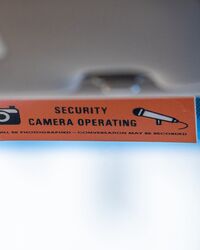Background
Due to the anonymous nature of rank and hail passenger services, additional safety and security equipment, such as security camera systems, are required in taxis to ensure the safety of passengers and drivers.
The use of security camera systems in taxis providing rank and hail passenger services is critical in supporting the safety of drivers and passengers. All vehicles providing taxi passenger services in NSW must be fitted with an approved security camera system that is in good working order and complies with specifications under the law.
The purpose of a taxi’s security camera system is to record incidents in taxis for investigative purposes only. Footage of everyday passenger trips are not viewed or kept.
If a taxi does not comply with the approved security camera system specifications, the vehicle must not provide rank and hail services.
This fact sheet will help you understand taxi security camera systems and answer frequently asked questions.
What type of camera is required?
A security camera system includes the camera inside the vehicle, as well as the software used to download, store, reproduce and manage recordings.
The internal camera must be visible to all passengers in the vehicle.
The camera must be impact and shock resistant enough to tolerate a typical car accident and the vibrations of normal taxi operation. The system must also work within a temperature range of -5°C to +60°C and up to 85% relative humidity.
For more information about security camera specifications, refer to the Approved security camera system specifications document.
When must a security camera system be ‘on’?
A taxi’s security camera system must be ‘on’ and be fully operational whenever:
- the vehicle’s ignition is ‘on’
- the taxi is available for hire and the ignition is not ‘on’ (for example, at a taxi rank).
The security camera system must have an indicator to show when the system is turned on and working, and when the camera is not working.
The driver must be able to see whether the camera is working or not working when seated in the normal driving position.
What signage is required?
Taxis must display signs which inform passengers and prospective passengers that they may be under video surveillance while they are in or around the taxi.
These signs must be clearly displayed both inside and outside the vehicle.
How are video recordings stored, accessed and downloaded?
All recordings must be stored in a secure manner. That is, password protected, or encrypted, and able to be recovered following loss of power to the camera system.
Safeguards must be taken by the service provider to ensure that all recordings are managed in a way that protects their quality and prevents them from being lost or accessed by an unauthorised person.
Recordings must be properly destroyed or deleted sometime between 30 days and 90 days after the recording was downloaded.
In certain circumstances, video recordings may be needed for law enforcement and investigative purposes. In such circumstances, recordings may be provided to a police officer, or an officer authorised by the Point to Point Transport Commissioner or Police Commissioner.
Only an authorised person may turn ‘off’ or disable any security devices, remove memory, store or access recordings. Recordings may be accessed for authorised purposes such as testing and maintenance of the system or for issuing a penalty notice.
What is considered ‘tampering’ with security cameras?
It is an offence to tamper with a security camera system or prevent a camera from being operational.
Tampering may include:
- removing fuses or having switches installed for manual override
- covering the camera lens or placing items next to the lens to block the camera
- any other actions that may interfere with the camera capturing and recording footage.
Service providers must ensure that controls are in place to ensure security cameras are
not tampered with.
What record keeping is required?
Records detailing the actions taken to comply with security camera system specifications and safeguards must be kept.
The type of records include:
- details of processes and policies showing how you maintain the compliance of your security camera system.
- details relating to the download of images/recordings, for example:
o Incident: Records must include all important details such as the date/time of download, reason, incident, vehicle and driver details and any details specific to the event.
o Test: If you need to download a camera system recording as a test.
- how and when recordings are deleted.
Who is responsible for security camera systems?
Taxi service providers, affiliated providers, facilitators and taxi licence holders may use the checklist below to ensure they are complying with their obligations:
| Supply a properly fitted, approved security camera system that is in working order | ✔ |
| Display proper signs inside and outside the taxi, warning of video surveillance | ✔ |
| Provide and operate a system that can produce recordings from a security camera | ✔ |
| Provide appropriate safeguards to protect against misplacement and misuse of video recordings | ✔ |
| Properly destroy or delete video recordings sometime between 30 days and 90 days after the recording was downloaded | ✔ |
What do drivers need to do?
Drivers should ensure the security camera system is operational and the indicator light is always turned on as a part of their pre-departure check and throughout their shift.
Rank and hail passenger services must not be provided if the camera is not working.
Drivers should also ensure all required signage is in place and visible to passengers and prospective passengers.
Further education
Related resources are available from the Learning Centre and the following links:
- Approved security camera system specifications
- Safeguards for the Use of Security Camera Systems in Taxis in NSW
If you have any questions or need further information, please visit the Point to Point Transport Commissioner’s website pointtopoint.nsw.gov.au or call the Industry Contact Centre on 131 727.

